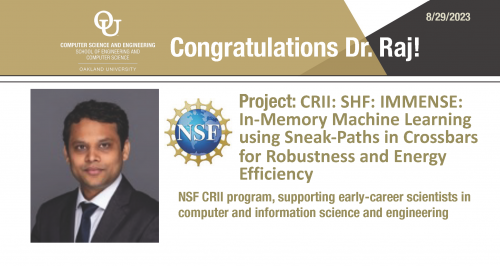CSE Assistant Professor Sunny Raj was awarded an NSF CRII grant for the project IMMENSE: In-Memory Machine Learning using Sneak-Paths in Crossbars for Robustness and Energy Efficiency.
The demise of both Moore’s law and Dennard scaling has led to a slowdown in the rate of improvement in energy efficiency that is being experienced today. This slowdown and the von Neumann bottleneck adversely affect a data-rich and machine learning (ML) dominated future. In-memory computing using memristor crossbars has emerged as an attractive choice as it is likely to be more energy-efficient than traditional approaches and does not suffer from the von Neumann bottleneck. However, existing in-memory memristor-dependent methods, such as neuromorphic computing, suffer from resistance drift leading to inaccurate output and high energy utilization, and are not robust against radiation damage. This project seeks to pursue a new approach to crossbar computing that transcends current neuromorphic approaches and counterintuitively leverages sneak paths in 3-D crossbars of emerging devices for performing computations. The societal impact of energy-efficient and radiation-hardened machine learning devices enabled by this project will be enormous. The low energy requirements of flow-based memristor crossbar computing will enable the goal of energy-efficient ML systems. Since these devices are robust against radiation damage, they will allow their use in radiation-rich environments such as space. The project seeks to train undergraduate and graduate students in the science of flow-based crossbar computing and prepare an inclusive next-generation workforce in the area of electronic design automation. The results of the project will be publicly disseminated at conferences and workshops to ensure a wide reach to stakeholders in academia, government, and industry.
The project aims to answer the following question: How to design in-memory crossbar circuits for machine learning algorithms such as support vector machines and deep neural networks for energy-efficient predictions while being robust against resistance drift and radiation degradation. The goal of this project is to create algorithms for mapping programs to 3-D crossbars and their theoretical characterizations that explain the computing capacity of crossbars in the context of data structures, such as different types of decision diagrams used in formal methods. The three primary objectives are as follows (i) identify bipartite data structures as transformation targets for non-kernel ML algorithms such as random forest, linear and logistic regression, (ii) determine novel spatial abstractions of memristor crossbar to allow efficient memristor utilization for lower energy and space utilization, and (iii) identify function composition operators for crossbar abstractions to enable mapping kernelized ML algorithms onto crossbars.


